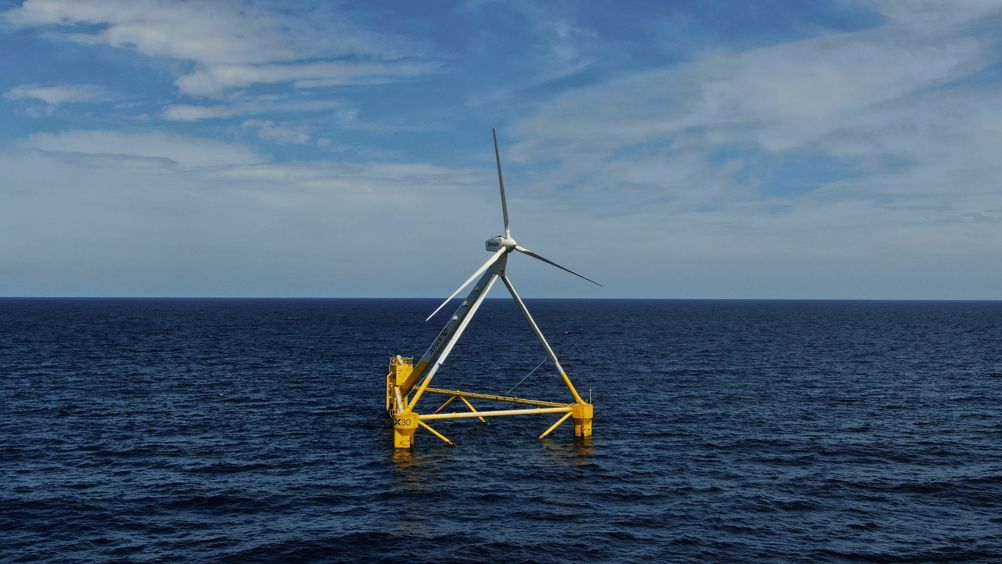The PivotBuoy Project represents a groundbreaking endeavor in the world of renewable energy. Specifically, the project introduced an innovative floating wind platform, the X30, a part-scale prototype that brings significant disruption and cost reduction potential to the floating offshore industry.
One of the standout features of X1 Wind's floating wind platform technology lies in its novel structural configuration with passive weathervaning and self-orientation capabilities. This is achieved through the integration of a Single Point Mooring (SPM) system with a small tension leg platform (TLP), eliminating the need for an active yaw mechanism. When combined with a downwind turbine, this innovative design allows for a complete overhaul of the traditional floating structure. It replaces the conventional tower with a "tripod-shaped" platform that excels in load distribution efficiency. Consequently, this design alteration significantly reduces the platform's weight compared to spar and semisubmersible systems.
The TLP mooring system is particularly well-suited for deep waters, in contrast to the more commonly employed catenary mooring lines. The TLP mooring system allows for cost-effective deployment of floating wind platforms in water depths ranging from 60 meters to over 500 meters. Furthermore, its verticality enables a very small seabed footprint (around 30x30m in a commercial size unit) and minimizes environmental impact, whereas catenary lines extend horizontally by 8-10 times the water depth (often reaching a 1-2 km to each side of the floating platform). This smaller footprint enhances the compatibility with other marine activities, like fishing, and also allows for a substantially larger number of platforms in the same given offshore area. A 20kV dynamic cable was installed to export electricity and, additionally, to investigate how the TLP mooring system could reduce cable movements and loads when compared to catenary systems. This reduction has the potential to mitigate fatigue and extend the lifespan of this crucial component.
The main objectives of the project were to prove the platform alignment, stability, and dynamic behaviour. The data collection and analysis started with the platform installation in October 2022. In March 2023, once PLOCAN's smart grid had been completed and commissioned, the X30 prototype generated its first kilowatt-hour, marking a historic milestone as the world’s first fully operational floating wind platform with a TLP mooring system to export electricity, as well as Spain's first floating wind prototype capable of exporting electricity via a subsea cable.
The PivotBuoy Project came to an end with the decommissioning of the X30 prototype in May 2023, in line with the official project schedule. The project yielded very good results that are aligned with the predictions made by simulation models. These outcomes encompassed the platform's stability during both regular and extreme weather conditions, its structural behavior, and the effectiveness of the passive alignment system, among other aspects.

In terms of power generation, the production of the modified Vestas V29 operating in downwind configuration was well aligned with the theoretical models, with no sign of power loss or increased 3P vibration due to tripod shadow It's also noteworthy that the turbine operated with the same controller as its onshore counterpart, highlighting how the stability provided by the TLP allowed the platform to maintain low pitch motions under typical production conditions. This effectively eliminates the need to introduce changes into the turbine's control vs bottom fixed turbines, as it is sometimes the case in other floating wind platform designs.
The data collected also showed excellent passive alignment of the platform with the wind. In fact, the alignment capabilities of the platform are better than publicly available data for traditional active yaw systems for strong winds (>7.5m/s), when most power production occurs, and similar for lower wind speeds (<7.5m/s). When taking into account the minimal maintenance requirements and the high reliability of the components employed in the passive yaw system, the advantages of this system become even more clear, especially when applied to large-scale floating offshore wind farms.
The data collected from the prototype is serving as valuable input for the development of commercial-scale platforms currently in progress by X1 Wind. The project outcomes underscore the significant positive impact brought about by the integration of the Single Point Mooring (SPM) with the TLP. Together with the industrialization of the design for commercial projects, this technology brings substantial cost reductions that will improve the competitiveness of floating wind and substantially reduce its LCOE level.

Alex Raventos is CEO & co-founder of X1 Wind











Guest blog: exploring opportunities for hydrogen combustion engines
"We wouldn't need to pillage the environment for the rare metals for batteries, magnets, or catalisers". Batteries don't use rare...